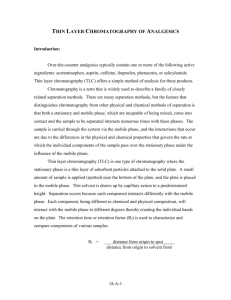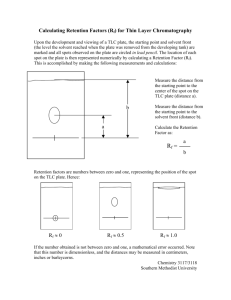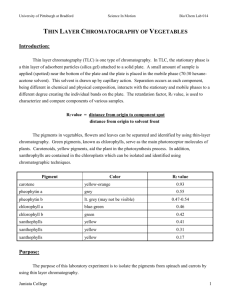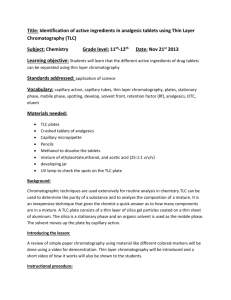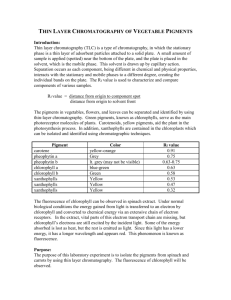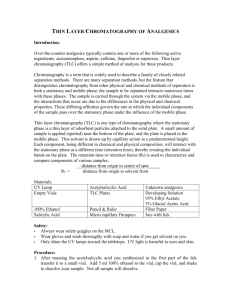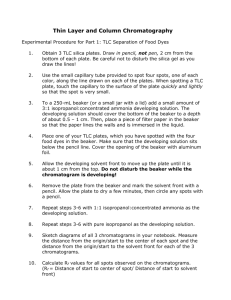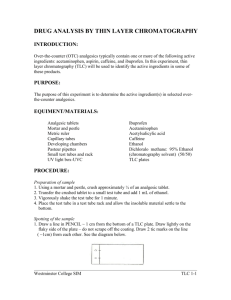THIN LAYER CHROMATOGRAPHY OF ANALGESICS
advertisement
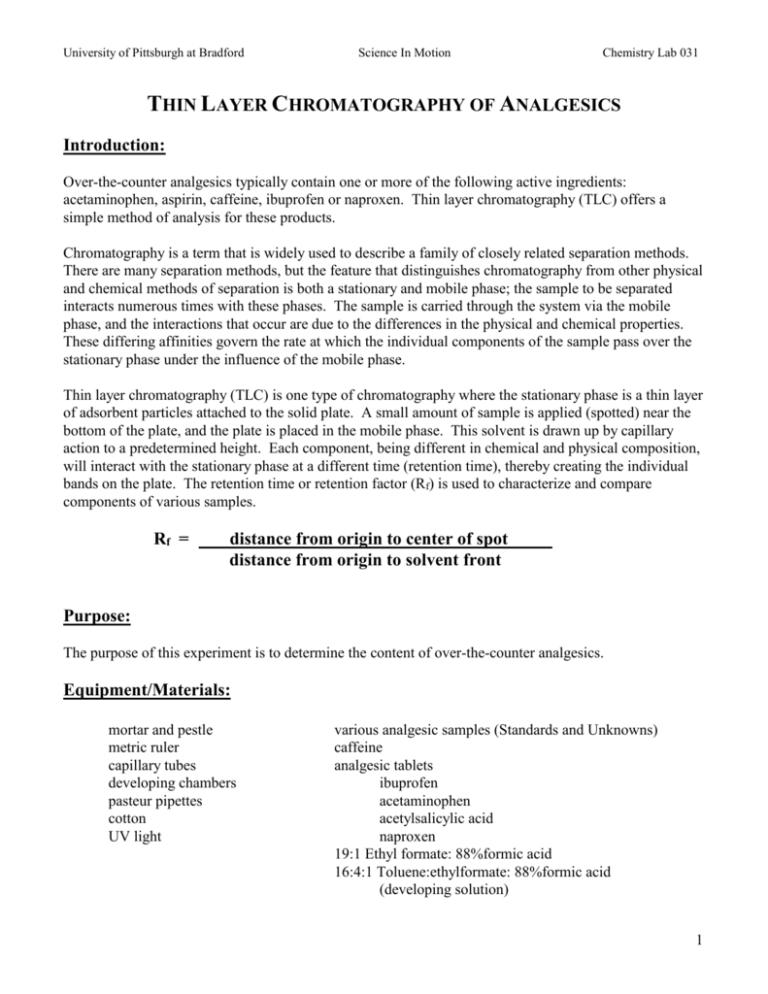
University of Pittsburgh at Bradford Science In Motion Chemistry Lab 031 THIN LAYER CHROMATOGRAPHY OF ANALGESICS Introduction: Over-the-counter analgesics typically contain one or more of the following active ingredients: acetaminophen, aspirin, caffeine, ibuprofen or naproxen. Thin layer chromatography (TLC) offers a simple method of analysis for these products. Chromatography is a term that is widely used to describe a family of closely related separation methods. There are many separation methods, but the feature that distinguishes chromatography from other physical and chemical methods of separation is both a stationary and mobile phase; the sample to be separated interacts numerous times with these phases. The sample is carried through the system via the mobile phase, and the interactions that occur are due to the differences in the physical and chemical properties. These differing affinities govern the rate at which the individual components of the sample pass over the stationary phase under the influence of the mobile phase. Thin layer chromatography (TLC) is one type of chromatography where the stationary phase is a thin layer of adsorbent particles attached to the solid plate. A small amount of sample is applied (spotted) near the bottom of the plate, and the plate is placed in the mobile phase. This solvent is drawn up by capillary action to a predetermined height. Each component, being different in chemical and physical composition, will interact with the stationary phase at a different time (retention time), thereby creating the individual bands on the plate. The retention time or retention factor (Rf) is used to characterize and compare components of various samples. Rf = __ distance from origin to center of spot_____ distance from origin to solvent front Purpose: The purpose of this experiment is to determine the content of over-the-counter analgesics. Equipment/Materials: mortar and pestle metric ruler capillary tubes developing chambers pasteur pipettes cotton UV light various analgesic samples (Standards and Unknowns) caffeine analgesic tablets ibuprofen acetaminophen acetylsalicylic acid naproxen 19:1 Ethyl formate: 88%formic acid 16:4:1 Toluene:ethylformate: 88%formic acid (developing solution) 1 Procedure: Preparation of sample 1. Push a small wad of cotton through the top of a pipette so that it forms a plug at the point where the pipette narrows. 2. Pulverize an analgesic tablet and transfer the tablet to the pipette. 3. Fill the pipette with 19:1 Ethyl formate: 88% formic acid to dissolve some of the analgesic and then force the solution out through the cotton filter into a vial. 4. Label the vial with the name of the analgesic being tested. 5. Repeat the procedure for each of the available tablets and known standards. Spotting of the sample 1. Draw a line in PENCIL ~ 1 cm from the bottom of the plate. Draw lightly on the flaky side of the plate – do not scrape off the coating. Place 2 tic marks on each line ~ 1 cm from each other. See the diagram below. 2. Immerse the pointed end of the capillary tube into the sample vial until some of the sample is drawn into the tube. 3. Very gently press the small end of the tube onto the plate at one of the tic marks. Keep the spots small and concentrated by applying the sample at least 3 times and allowing the spot to dry between applications. 4. Repeat this procedure for each of the standards available. 5. Two or more samples may be applied to each plate of they are kept one cm apart. Mark the position of the spots lightly in PENCIL, and be sure to keep a record of which spot represents each product. See diagram. Development of the TLC plates 1. Prepare a developing chamber by placing enough solvent to make a layer on the bottom. (16:4:1 Toluene: ethyl formate: 88%formic acid). 2. Place the TLC plates in the chamber spot side down, so that their fronts do not touch. Allow the solvent to rise to within one cm of the top of the plates. 3. Remove the plates, mark the solvent front, and allow them to dry. 4. Visualize the spots by illumination under a UV lamp. 5. Trace around each spot with a pencil and then measure the distance traveled by each component. 6. Calculate the Rf by dividing the distance of the solvent front by the distance of the spot. The Rf value is characteristic of each substance and may be used for identification of the substance. 2
